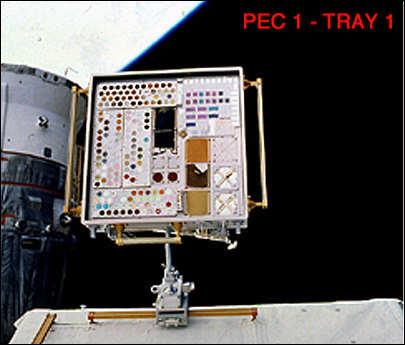NASA’s George C. Marshall Space Flight Center is teaming up with Intermec, a vendor of automatic-identification technologies, including bar-code equipment, mobile computers and RFID systems, to send RFID tags into space.
Under a partnership announced Wednesday, NASA and Intermec are collaborating on researching auto-ID technologies, including RFID and Data Matrix markings. Plans call for the inclusion of two or three different RFID tags in an experiment to be conducted later this year on the International Space Station. This, NASA says, will be the first time RFID tags have been exposed to the conditions present in space.

The goal of the experiments is to see how RFID tags and other identification technologies fare when exposed for an extended length of time to the environmental conditions of space. During a shuttle mission to the space station planned for July, NASA astronauts will mount aluminum briefcase-sized containers to the exterior of the spacecraft. The materials being tested will be inserted in coin-sized slots on the container for exposure to the conditions 350 kilometers above Earth. After several months in space, the materials will be retrieved and returned to Earth, where they will be analyzed and tested to gauge the impact of such things as atomic oxygen (individual oxygen atoms), ultraviolet radiation and micrometeorites.
Under the joint research agreement, Intermec will also evaluate the readability of identification markings on materials undergoing long-term exposure to space, as part of the Materials International Space Station Experiments (MISSE) 3 and 4, which were initiated last August. Those materials are still on the space station, and NASA astronauts are expected to return them to Earth within a few months.
Intermec will also prepare Data Matrix markings and supply both soft and rigid RFID tags for the MISSE 6 experiment, scheduled for a July launch. Fred Schramm, administrator of the Internal Research and Development Program at the Marshall Space Flight Center, says Intermec will use off-the-shelf products for the experiments. Intermec markets a variety of RFID tags, including two “Rigid” models designed to withstand harsh industrial conditions. Those products are passive UHF tags available in EPC Global Gen 2 and ISO 18000-6B versions.
“The idea is to find out how well commercial products survive and perform,” says Larry Huseby, Intermec’s director for public sector business development. “Test results could affect if and how NASA uses RFID in their missions.”
According to Schramm, NASA supplied Intermec with samples of aluminum-lithium alloys, the material from which the space shuttle’s external tank is made. Intermec then used laser bonding to apply Data Matrix patterns to the samples. Also set to be tested in MISSE 6 are nanocodes, or chemical bar codes. The materials and tags that are still readable after long-term exposure to space, Intermec says, will be certified for use on future space vehicles and added to NASA’s part-identification requirements.
“The samples are ‘coupons’ made of different types of material and marked with different types of direct part marking [DPM] technologies, so that many unique combinations of materials and DPM marking technologies are included,” explains Huseby. “The coupons are exposed to the hostile environment of space to determine which DPM marking methods work best for each type of material,”
NASA has been working for years on testing and developing the technology and materials needed to identify and track parts and supplies for its fleet of spacecraft. During the MISSE 1 and 2 experiments, deployed on the station in August 2001, Schramm says the Data Matrix samples held up well to the exposure to space. RFID technology, he adds, is promising because of its ease of use in an environment where every part, and all supplies and equipment, must be carefully tracked and accounted for. “We like RFID,” he says.
One challenge for NASA researchers, says Schramm, is improving inventory control without creating extra work for the astronauts. The protective gear and clothing, particularly the heavy gloves worn by astronauts outside the space vehicles, “aren’t conducive to pushing buttons and handling scanners,” Schramm says. The agency expects, however, that astronauts will find RFID interrogators easy to operate in space.
In the long term, NASA and Intermec see broader commercial—and earthbound—applications for the auto-ID technologies the experiments will advance. In particular, Schramm envisions the potential use of such technologies in anticounterfeiting efforts across a range of industries and with a variety of goods, from aerospace parts to construction materials to cultured pearls.
“Both NASA and Intermec have substantial patent portfolios in the area of scanning and imaging,” says Huseby. “We are exploring opportunities to pool our technologies, and perhaps cooperate on some research projects that could have commercial product implications in the future.”

